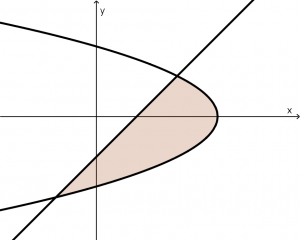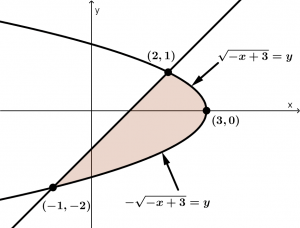As a first exercise, let’s start with something “complex”. We will calculate the area between the following functions:
- x=3 - y^{2}
- y = x - 1
The first thing that is recommended is to try to sketch the graphs to have a better idea of how we are going to work. If possible, use a graphing tool such as GeoGebra.
The functions plotted in the program will look like this:

And the shaded area that is displayed between the functions is the one that will be calculated in this exercise.
First we are going to calculate the intersection between curves, this calculation is important because it is the one that will define the limits of our integrals. To make this calculation we will take the function 1 and its unknown of y we will replace it with the function 2, mathematically it is like this:
x = 3 - y^{2}
x = 3 - (x - 1)^{2}
Now that we have an equation with only one type of unknown, we proceed to equal it to zero to find the values of x in which the functions intersect, let’s squared the binomial:
x = 3 - (x^{2} - 2x + 1)
Multiply that negative sign to the whole parenthesis:
x = 3 - x^{2} + 2x - 1
Now let’s equalize to zero:
x^{2} - x - 2 = 0
Once we have the quadratic equation as small as possible, we will factor it to obtain the values of x:
(x - 2)(x + 1) = 0
What gives us as a result that there is a point that has the value of x = 2 and the other point has the value of x = -1.
We can easily find the values of y of each point using function 2, which is easier to do calculations than function 1. We only have to replace each value obtained from x:
When x = -1
y = x - 1 \ \rightarrow \ y = -1 - 1 = -2
When x = 2
y = x - 1 \ \rightarrow \ y = 2 - 1 = 1
So our points of intersection between the two functions are (-1,-2) and (2,1)
Having found the value of x was more than enough, only that as we are going to calculate the area with reference to the Y-axis, we calculate the y‘s.
A point that we have not calculated that is very important is the vertex of the parabola of function 1, to calculate it you only have to equal the value of y to zero and we will have the value of x:
x = 3 - y^{2} = 3 - (0)^{2} = 3
We just need to separate function 1, we will put it as a function f (x) , the part of the function that is above the X-axis will be as follows:
y = \sqrt{3 - x}
And the part of the function that is below the X-axis will look like this:
y = - \sqrt{3 - x}
Everything we just calculated from points of intersections and function 1 that we had to separate into two functions, we will represent in the following figure:

Let’s start with the integrals
This works like this, we are going to need two integrals and what is going to be integrated is going to be the function that is above minus the function that is lower than the area that we want to find. Our first integral will have limits of -1 to 2:
\displaystyle \int_{-1}^{2} \left[ (x - 1) - \left( -\sqrt{-x + 3} \right)\right] dx
And our second integral will have limits of 2 to 3:
\displaystyle \int_{2}^{3} \left[ \left(\sqrt{-x + 3} \right) - \left( -\sqrt{-x+3} \right) \right] dx
So our area is calculated with the sum of the two proposed integrals:
\displaystyle A = \int_{-1}^{2} \left[ (x - 1) - \left( -\sqrt{-x + 3} \right)\right] dx + \int_{2}^{3} \left[ \left(\sqrt{-x + 3} \right) - \left( -\sqrt{-x+3} \right) \right] dx
You can use a calculator to quickly obtain the value of the integrals, only here we will explain step by step the resolution of the integrals.
Let’s reduce the parentheses of the integrals:
\displaystyle A = \int_{-1}^{2} \left[ (x - 1) + \sqrt{-x + 3} \right] dx + \int_{2}^{3} \left[ \sqrt{-x + 3} + \sqrt{-x+3} \right] dx
We sum the two roots of the second integral and by properties of the integrals we can extract the 2 from the integral:
\displaystyle A = \int_{-1}^{2} \left[ (x - 1) + \sqrt{-x + 3} \right] dx + 2\int_{2}^{3} \left[ \sqrt{-x + 3}\right] dx
We can easily make the integrals. Integral of x is equal to \frac{x^{2}}{2}, integral of a constant is equal to the constant multiplied by x and to realize the integral of the square root we have to apply rule of the chain that will result in an integral of \sqrt{-x+3} is equal to \frac{2}{3}\left( -x + 3 \right)^{\frac{3}{2}}. The second integral is applied to the rule of the chain and \frac{2}{3} multiplied by the 2 that is outside the integral, which will result in a -\frac{4}{3}:
A = \left[ \cfrac{x^{2}}{2} - x - \cfrac{2}{3} \left(-x + 3 \right)^{\frac{3}{2}}\right]_{-1}^{2} + \left[-\cfrac{4}{3} \left(-x + 3\right)^{\frac{3}{2}} \right]_{2}^{3}
We will evaluate with their respective limits:
A = \left[ \left(2 - 2 - \cfrac{2}{3} \right) - \left( \cfrac{1}{2} + 1 - \cfrac{16}{3} \right) \right] + \left[ 0 + \cfrac{4}{3} \right] = \cfrac{9}{2} \ \text{u}^{2}
Which gives us as a result that the area between the two functions is equal to \frac{9}{2}\ \text{u}^{2}
Change of reference system
We will take as a reference system the Y-axis.
It will seem that it is more difficult, but the truth is that it is easier and faster to calculate this exercise when we take as a reference system the Y-axis. The same steps are going to be taken, only with this reference system we are only going to propose one integral. The limits are the points of intersection that we had already calculated and what will be integrated will be the function that is higher (the one that is more to the right) minus the function that is lower (the one that is more to the left) of the area that you want to calculate. Let’s see:
\displaystyle A = \int_{-2}^{1} \left[ \left(3 - y^{2} \right) - \left(y + 1\right) \right] \ dy
We simplify the parentheses that the integral has:
\displaystyle A = \int_{-2}^{1} \left[ 2 - y^{2} - y \right] \ dy
Integral of a constant is equal to the constant for y, the integral of y^{2} equals \frac{y^{3}}{3} and integral of y equals \frac{y^{2}}{2}:
A = \left[2y - \cfrac{y^{3}}{3} - \cfrac{y^{2}}{2} \right]_{-2}^{1}
We just need to evaluate and we will almost have finished:
\left( 2 - \left(\cfrac{1}{3} \right) - \left( \cfrac{1}{2} \right) \right) - \left( - 4 + \left(\cfrac{8}{3} \right) - (2) \right) = \cfrac{9}{2} \ \text{u}^{2}
Finally our calculated area is equal to \frac{9}{2}\ \text{u}^{2}
What has been demonstrated is that the same area can be calculated by taking different reference systems and even a reference system can be much easier than the other, in the end it is each one’s decision to use the reference system they want, what matters is to obtain the correct result.
Thank you for being at this moment with us : )
